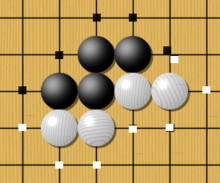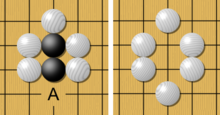Go/Lesson 2: Basic Rules and Foundational concepts
Basic Rules
[edit | edit source]Liberties
[edit | edit source]
One very important concept in the game of Go is the concept of liberties, or free intersections surrounding a stone. To count how many liberties a stone has you have to simply count how many free intersections, surrounding that stone, aren't occupied by other stones. So a lone stone in the middle of the board has four liberties (intersections placed diagonally to each other aren't connected), while a lone stone on the side of the goban has only three liberties and one placed in a corner has two.
Whenever an enemy stone occupies one of these intersections, the original stone loses one liberty (since the intersection isn't free anymore). It's also true that placing a stone of the same colour on an adjacent intersection reduces the liberties of the first stone by one, but they form a group, so their individual liberties aren't as valuable as before.
When two or more stones, of the same colour, are placed on adjacent intersections (remember, not diagonally) they form a group. When a group is formed, its liberties are now the sum of free intersections adjacent to any single stone composing the group itself. So two adjacent stones, in the middle of the board can have at most 6 liberties (three for each stone, since the fourth liberty is occupied by the other stone in the group). We can see that grouping stones is a good way to increase liberties.
Capturing
[edit | edit source]
To capture a stone, or a group of stones, one must completely cut off all of its liberties (in other words, the stone is surrounded on all four sides). Once a stone is captured, it becomes a prisoner. This is important, because for every stone captured, a point is subtracted from that player's total amount of territory. Capturing works the same way with groups of stones — all captured stones are removed from the board and kept by the player who captured them. The area where the stones were removed from becomes the territory of the capturing player.
You may not place a stone in a space where in doing so, immediately cuts off all the liberties of your stone or group. This is called suicide and it is illegal.
Atari
[edit | edit source]
A stone with only one liberty remaining is in "atari." This means the stone is vulnerable to capture in a single move by the opposing player. This is somewhat comparable to "check" in the game of Chess, but occurs more often and is "less important" to the overall strategy of the game. In Chess, when the King is in check, direct action must be taken to resolve this (e.g., the king must be moved out of check, another piece must move to block the attacking piece, or the attacking piece must be captured). In Go, there is no such requirement; when a stone is placed in atari, it is not necessary to respond at all. The stone can remain in atari for many moves, or be captured by the opposing player immediately, or protected by the attacked player immediately. When a stone is placed in atari, a player may see fit to attack another area of the board or continue working to capture other territory. A player placing an opponent's stone in atari is not required to announce it.
Learn to recognize capturable stones and groups: Go/Capturing exercise
Ko rule
[edit | edit source]
A ko is a shape (an arrangement of stones) where one player is able to capture exactly one of his opponent's stones with one move, but after capturing the stone his opponent is able to capture (in one move) the stone that was just played again, creating an opportunity for his opponent to capture that stone in the same way again. One could capture back and forth in a ko indefinitely. During the early eras of Go, this cycle could happen indefinitely and stop all progress in the game, so a rule was made to stop this from continuing. The rule of ko states that the same board state cannot happen twice, forcing players to play in another place before they can play at the ko again. This gives the first player a chance to fill in the ko and stop the fight.
To prevent the first player from settling the ko, the second player must compel the first to also play elsewhere. This is done by identifying locations where, if the second player could play two stones in a row, the result would cost the first player more than winning the ko gains. These are called ko threats and can include threatening to rescue a large dead group, kill a large living one of the opponent, or mount a costly invasion into the opponent's territory. If the first player responds, the second player is now allowed to retake the ko and it is the first player who must now find a ko threat. If the first player ignores the threat and settles the ko, the second player follows through on their threat and takes some compensation for losing the ko.
Handicaps
[edit | edit source]
To balance a game being played between players of significantly different skill, the weaker player is sometimes granted a handicap of one or more "free" stones. Some rule sets (Chinese, New Zealand, etc.) allow these to be placed anywhere the player desires. Other rules (Japanese, e.g.) have predefined handicap placement. Placing handicap stones is treated as black's first move, so white moves first after the handicap stones have been placed. One handicap stone is often given for every on rank difference between players. Thus if a player (white) with the rank of 7 kyu played a player (Black) with a rank of 12 kyu black would receive a handicap of 5 stones. though if the two players are only a rank or two different it is often unnecessary to use a handicap. In addition, one handicap stone is worth roughly 10 points, so if either you or your opponent does not know their rank play an even game and if one player loses by a large margin give them one stone for every ten points they lost by (as an estimate) and play another game. Repeat this until the proper handicap has been reached.
Komi
[edit | edit source]In even games (games without any handicap stones), white is given a compensation for the fact that black moves first. In Japanese rules, this compensation is worth 6.5 points (the half point ensuring that no game will ever be drawn). In handicap games, white is occasionally given a half (0.5) point of compensation, simply to prevent a draw from occurring.
Reverse Komi
[edit | edit source]Sometimes, instead of giving white the compensation (komi), black is given that compensation instead, as a sort of handicap. This is occasionally referred to as a "one-stone handicap", but is more popularly and simply called "reverse komi".
Foundational Concepts
[edit | edit source]Placing Stones
[edit | edit source]
Stones are placed at the points created by the intersecting lines of the grid. A stone may be placed on any empty point, unless that point has no adjacent empty points and the placement does not cause the capture of adjacent enemy stone(s). The traditional way of placing stones on the board is by grasping the stone with the index and middle fingers, with the stone held horizontally between the index (below) and the middle (on top) fingers. This may feel awkward the first few times it is done, but it is the most optimal way of placing a stone.
Surrounding Territory
[edit | edit source]Territory is surrounded when all of the points/intersections in an area are controlled by a single colour. Only an outline is needed to claim territory — placing stones at every point within an area will not claim territory (and in fact reduces the actual territory claimed — in Japanese rules the game is scored by counting open territory claimed, not spaces occupied by stones). An "eye" is one example of a group (joined stones) that claims territory. An opponent may play within territory if it is legal to do so.
Groups
[edit | edit source]A group is a group of connected stones.
Cutting
[edit | edit source]Cutting occurs when a stone is placed between two groups of enemy stones in order to prevent the groups from connecting.
Perhaps this should be moved more towards an intermediate level
Initiative (Sente - Gote)
[edit | edit source]Sente is when a player is "ahead" of his opponent if you will. It is when he forces the other player to respond to his moves. It is said that this player is in sente and his opponent in gote.
This section needs to be expanded. It may also need to be moved to a more intermediate level
Life and Death
[edit | edit source]A dead group is one that is unable to make more than one eye. Such a group is at risk of capture because it cannot be completely defended. A live group is one that is able to make two or more eyes. This is a very powerful group because the enemy cannot attack it successfully; any attack will result in immediate suicide or eventual capture of more territory or stones by the owner of the live group.
Groups can sometimes be neither completely dead nor completely alive.
Eyes
[edit | edit source]
A single group of interconnected stones with one point of territory forms an eye. A group with two or more eyes cannot be captured, as at both points white could not play without the stone played having no liberties (called suicide, and is not a legal move in the Japanese rule set), and is a powerful structure within the game.
Tsumego
[edit | edit source]Tsumego is Japanese for life and death problems. You are given a situation and you have to figure out how to make a group live (or how to kill a group). There are several sites that offer life and death problems, for example goproblems.com. There are also books containing these problems.
Tsumego is one part of Go/Igo/Baduk/Wei Qi, though studying tsumego alone isn't enough to progress it may help a lot in battles, as well as your calculative abilities and your ability to perceive weak groups.
Seki
[edit | edit source]A Seki situation happens when opposing groups are placed so that both depend on the same liberties to survive. Neither player can place the other into atari because this would place themselves into atari as well. Seki situations are usually left alone until the end of a Go game. The free points in them are not counted when it's time to count for scoring.
Order of play
[edit | edit source]Exigent
[edit | edit source]First you should play the most urgent or necessary moves. These are the moves that could cause you to lose considerable amount of territory or weaken your position. Ask yourself: do I have any groups that could be killed in less than three turns, and should I protect them?
Exploit
[edit | edit source]If you can find no moves of the first type, you should look for ones that take advantage of an opponent's weakness. Also find what would be your opponent's urgent moves and block those, or otherwise take advantage of them.
Expand
[edit | edit source]If there are none of the first two types of moves then find the move that would take the most territory or the biggest move.
